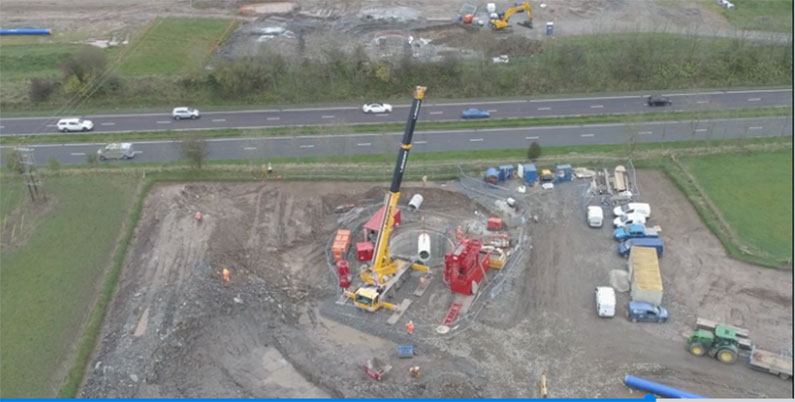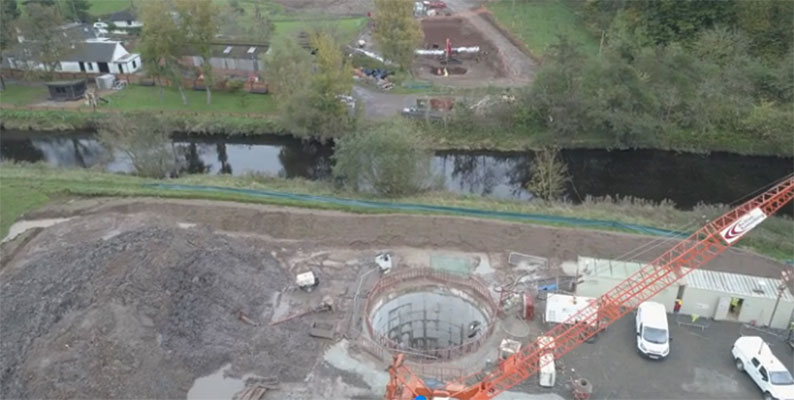Microtunnels minimise disruption in Scotland 30 Nov 2017
Two new sections of water main pipe have been installed by Scottish Water as part of its £120 million water supply investment to improve water supply to more than 200,000 people in Ayrshire and east Renfrewshire, Scotland.
For the first section, partner Caledonia Water Alliance chose an Iseki 1500 TBM to excavate a 1.2m diameter 60m long tunnel below the A77 near Kilmarnock for a 67m long steel pipe. Excavation started in mid-October 2017, took five weeks to complete, and involved no closure of roads or disruption to traffic. If the pipe had been installed by open cut method the work would have required lane closures with temporary traffic lights or possibly a full road closure.
A Herrenknecht 1500 TBM was selected for the second section to install the 70m-long 1.5m diameter tunnel four metres below the bed of the River Irvine west of Hurlford between the A77 and the B7073. About 275 tonne of material was excavated without disturbing the river or the aquatic environment. If a trench had been excavated to install the pipe the river would have had to be diverted.
“We are continuing to make good progress with the project,” said Sean Lavin, Senior Construction Manager.
“We sought to minimise any disruption or inconvenience to road users. We recognised how busy the A77 is at this location and opted to construct a tunnel to avoid disruption.
“We also decided to tunnel beneath the River Irvine at Hurlford. Trenching and diverting the river would have been difficult due to the size of the river and lack of space at the crossing point and would have been more disruptive. At all times during this project, we aim to minimise disruption to road users and the natural environment.”
The second phase of the project includes the installation of 13 miles of water main from the Amlaird water treatment works in the Fenwick/Waterside area to Highlees pumping station near Dundonald in South Ayrshire. The first phase involved 13 miles of water main from near Newton Mearns, East Renfrewshire to the Fenwick/Waterside area in East Ayrshire, plus a pumping station at Darnley which is already built.
Customers in much of Ayrshire currently receive their water from the Bradan water treatment works, south of Straiton in South Ayrshire, which is supplied to taps via a 34-mile-long trunk water main that was installed about 50 years ago.
The construction of the new strategic water main, which is expected to be completed in 2020, will connect the Bradan water supply network to the network served by the Milngavie and Balmore water treatment works, north of Glasgow.
When complete, the investment will enable Scottish Water to transfer water from Glasgow to Ayrshire, and vice-versa and will create a larger, more robust and connected supply zone which will benefit customers in all surrounding areas.
Water supply upgrade for Ayrshire and Renfrewshire 22 Dec 2016
Significant engineering challenges are being overcome by Scottish Water during key stages of a £120 million investment in the drinking water network. Construction is being undertaken to install a strategic water main that will benefit more than 200,000 people in Ayrshire and parts of East Renfrewshire
The first phase of the project is the installation of a 13 mile-long section of water main from near Newton Mearns to the Fenwick/Waterside area.
The route of this section of main goes over mainly farmland and open moorland, and starts at Waulkmill Glen reservoir near Newton Mearns in the north and goes south to Amlaird water treatment works near Fenwick, with branches to the South Moorhouse and Corsehouse water treatment works.
During installation, Caledonia Water Alliance, partners to Scottish Water, have been tunnelling under the Neilston railway line near Barrhead, as no alternative crossing method was available. There were no local roads with sufficient access, width or height to enable normal open excavation methods to be used. After site investigation and liaison with Network Rail, work was started in late July/early August.
Using a TBM, Scottish Water is installing two parallel sections of concrete water main, each 85m long beneath the railway line to the south of Barrhead. The TBM is about 5m long and is remotely operated by a team at ground level. A further 2.5 mile stretch of water main is being installed across peat bogland.
“The work on the peatland on Fenwick Moor, and under the railway line near Barrhead, have presented us with major engineering challenges but we have met or are meeting those challenges head-on and progressing well with this important first phase of the overall project,” said Stewart Davis, Scottish Water’s Programme Manager.
Scottish Water announced in December 2015 that it would improve the water supply network by installing more than 30 miles of new water mains to connect the system in Ayrshire with the Greater Glasgow area’s network. This will enable Scottish Water to provide customers with greater security of supply and to respond more effectively to operational issues such as burst water mains and so minimise disruption to customers.
The other sections of new mains to be constructed will be about 13 miles from the Fenwick Waterside area to Dundonald in South Ayrshire and a section of about six miles from the Pollok area to a reservoir storage tank in the south of Glasgow.
References
- Excavation complete for Shieldhall sewer – TunnelTalk, October 2017
|
|
|
|
|
Add your comment
- Thank you for taking the time to share your thoughts and comments. You share in the wider tunnelling community, so please keep your comments smart and civil. Don't attack other readers personally, and keep your language professional.





